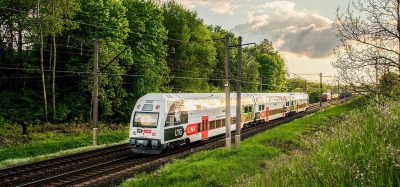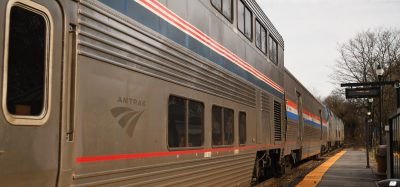Construction, maintenance and upgrading of tracks: the Austrian way
Posted: 1 August 2013 | | No comments yet
The liberalisation of European railways, particularly the free network access of passenger and freight traffic, have a basic influence on the construction of new lines and the maintenance and upgrading of tracks of ÖBBInfrastruktur AG. This article outlines the essential characteristics of track systems including track substructure.
Line layout and cross sections
Operating trains on a line that allows high speeds for passenger trains and low speeds for freight trains requires careful consideration about track alignment design. The maximum allowable values of cant deficiency (Imax = 130mm) and a max. cant excess (Emax = 110mm) enables expectable rail wear and reduced maintenance costs. A maximum gradient of 12.5‰ guarantees a load of 1,000 tonnes per freight train. A minimum radius of 3,000m enables a comfortable train speed of 200km/h, but 250km/h for trains with low axle loads is also possible.
The invention of the ‘Viennese Curve’ – a transition curve calculated for the centre of gravity of a vehicle – reduces lateral track forces and rail wear. In addition, this transition curve guarantees a full compensation of the rate of change of the lateral acceleration at the points of discontinuity – as a result, new and better passenger comfort will occur.
The liberalisation of European railways, particularly the free network access of passenger and freight traffic, have a basic influence on the construction of new lines and the maintenance and upgrading of tracks of ÖBBInfrastruktur AG. This article outlines the essential characteristics of track systems including track substructure. Line layout and cross sections Operating trains on a line that allows high speeds for passenger trains and low speeds for freight trains requires careful consideration about track alignment design. The maximum allowable values of cant deficiency (Imax = 130mm) and a max. cant excess (Emax = 110mm) enables expectable rail wear and reduced maintenance costs. A maximum gradient of 12.5‰ guarantees a load of 1,000 tonnes per freight train. A minimum radius of 3,000m enables a comfortable train speed of 200km/h, but 250km/h for trains with low axle loads is also possible. The invention of the ‘Viennese Curve’ – a transition curve calculated for the centre of gravity of a vehicle – reduces lateral track forces and rail wear. In addition, this transition curve guarantees a full compensation of the rate of change of the lateral acceleration at the points of discontinuity – as a result, new and better passenger comfort will occur.
The liberalisation of European railways, particularly the free network access of passenger and freight traffic, have a basic influence on the construction of new lines and the maintenance and upgrading of tracks of ÖBBInfrastruktur AG. This article outlines the essential characteristics of track systems including track substructure.
Line layout and cross sections
Operating trains on a line that allows high speeds for passenger trains and low speeds for freight trains requires careful consideration about track alignment design. The maximum allowable values of cant deficiency (Imax = 130mm) and a max. cant excess (Emax = 110mm) enables expectable rail wear and reduced maintenance costs. A maximum gradient of 12.5‰ guarantees a load of 1,000 tonnes per freight train. A minimum radius of 3,000m enables a comfortable train speed of 200km/h, but 250km/h for trains with low axle loads is also possible.
The invention of the ‘Viennese Curve’ – a transition curve calculated for the centre of gravity of a vehicle – reduces lateral track forces and rail wear. In addition, this transition curve guarantees a full compensation of the rate of change of the lateral acceleration at the points of discontinuity – as a result, new and better passenger comfort will occur.
The distance between track centres is 4.70m because of aerodynamic effects and mixed traffic. The whole width of the cross section is 17.55m. The 55cm ballast bed lays on a 70cm thick sub-grade or a 12cm thick asphalt layer. For maintenance reasons, a 60cm broad track access-path is located along both sides of the track to allow trains to pass while inspection or maintenance work outside the danger zone of the track is being carried out. Noise barriers are mounted 4.20m from the track centre and a 10cm uplift of the ballast bed is also incorporated into the cross profile as well as a 4cm reduction of the ballast bed in the sleeper spacing to avoid ballast flow at higher speeds.
In case of inconsistent load-bearing capacity on the formation and ground water sensitive areas, ÖBB has experience with using asphalt layers on the sub-grade beneath the ballast bed. This asphalt layer is hydrophobic and load distributing. It deters plants growing up into the ballast bed and separates definitively sub- from super-structure. Therefore, the effect of pumping up fine grains into the ballast bed is impossible. Calculations have shown an extended service life by more than 10% and tamping cycles by more than 30%. A lower ballast bed thickness is possible in combination with under sleeper pads (USPs) without reducing track geometry quality and the total maintenance costs decreases. In addition, an asphalt layer of 12cm is trafficable and extends the construction period, especially in winter times which is quite a good cost saving method for building high-speed lines.
Track components
Following the principles of an economic track, several track components in several basic and maintenance conditions and with different service lives need to be taken into account. A cost driver on the Austrian track system is taken into account and is based on the yearly depreciation of the assets, followed by opera – tional hindrances and maintenance costs. Therefore, the following two main strategies for an economic track are deduced:
● The initial quality must be the best possible
● Carrying out proper maintenance to extend service life is the best solution.
By applying these strategies, the following track components are implemented into the track: 60 E1 rail with concrete sleepers and a SKL-fastening System w14. The fully mechanised track plus switch and crossing laying guarantees the best initial quality. The better durability of tracks with concrete sleepers and USPs can be easily demonstrated with a measuring strip of the track recording car. The minor forces and settlement in the sub-grade leads to a much better durability of track geometry.
Switches and crossings for speeds more than 200km/h are designed with an inclination of 1 in 40 and a moveable manganese point. A hydraulic driven turnout with electronic detection system and encapsulated spherical locking placed in a hollow-sleeper has replaced the old mechanical clamp lock.
Today, modern turnouts are assembled with all combination of modules for setting, locking and position monitoring completely at the plant. This ‘plug and play’ turnout can be delivered by special turnout transport wagons to the con – struction site ‘just-in-time’. The placement of a crane on a pre-compacted ballast bed shortens installation time and reduces track possession. High quality materials and mechanised installation guarantees the best initial quality for a long service life and extended inspection intervals of six months. To increase turnout geometry durability, the concrete bearers are mounted with USPs as well as track sleepers. Pads with different vertical stiffness and movable points ensure a smooth running at speeds above 200km/h.
On Austrian high-speed lines, slab track is applied in tunnels more than 500m-long or on short sections between two tunnels. The widely used slab track design has been developed jointly by Austrian Railways and Porr since 1989.
The main element of this type of ballastless track system is a conventionally reinforced precast concrete slab with two rectangular openings and an elastic separation layer applied to both the bottom of the slab and the side faces of the rectangular openings. The slab is placed on an appropriate foundation and, following final alignment of the rails, is concrete backfilled to ensure the transfer of forces. It is 5.16m-long, 2.40m-wide and 16-24cm-thick. The standard rail fastening element used is a Vossloh IOARV 300-1 with soft rail pads.
The advantages of this slab track system are the fast installation time, the minor costs, almost no maintenance actions and an easy change of the concrete plates in the worst case scenario of a derailment.
Maintenance
European recommendations for safety in railway tunnels are restrictive and costly. The Austrian philosophy is based on a self-rescue concept followed by intervention of the fire brigade. In addition, the operational provision prohibits a burning train to stop in the tunnel by an intelligent emergency brake override.
Together with Robel Bahnbaumaschienen, ÖBB has developed a Mobile Maintenance Unit for inspection and minor maintenance works on the track like welding, screwing or changing isolated joints.
One of the most interesting benefits is the protection of the workers from aerodynamic effects of passing trains. That’s why no speed restrictions occur on the nearby tracks in case of maintenance works.
Characteristics of track substructure
As a rule, layers with a thickness of 40cm are installed as a base/sub-base in the track roadbed. If the underlying subsoil is not strong enough, it will either be replaced or consoli – dated by the addition of a lime-cement mixture. This applies both to railroad construction and maintenance. In order to ensure the sustainability of the subsoil in the long-run, railway drainage is essential. The drainage will be built either as open ditches, concrete channel drains or drainage pipes.
In order to keep maintenance to a minimum, mostly open ditches and concrete channel drains are built. Furthermore, the service life of these two measures is significantly higher (about 80 years) than those of the drainage pipes (about 30 years). The regular maintenance works on the drainage include re-cutting and cleaning of the ditches, flushing of concrete channel drains and drainage pipes, flushing of culverts and constructing low-water channels and cleaning of manholes.
Retaining or supporting walls and support structures are erected if there is not enough space available for appropriate earthwork measures, or the stability of embankments cannot be achieved by earthwork measures alone. In terms of efficiency, stone gravity walls and concrete gravity walls are preferred. In order to increase the service life of the walls, the first priority in maintenance is to remove vegetation. With stone cladding and masonry, special attention is paid to the joints. The wall tops and guardrails are replaced or supplemented, if necessary. Trenches which were built as part of the wall construction are checked for their function and are restored.
For the construction of noise barriers, distinction is being made between noise mitigation as a maintenance measure and noise protection measures in the course of con – struction projects. The reason for this lies in the underlying legal framework in Austria.
Noise barriers are founded with steel ram piles. In the pile heads, steel uprights are concreted. Between the individual steel uprights, elements of concrete are used on which noise barrier elements are situated. In order to keep the maintenance costs low, the noise barrier panels are constructed mainly of aluminium or concrete. Wood panels are avoided due to service life issues. In the construction of noise barriers, particular attention is paid to the drainage of the track roadbed. It is important to avoid the drainage flow of the surface water being interrupted by the foundations of the noise barriers. Otherwise an un-drained roadbed would lead to a softening of the ground underneath the track and increase the maintenance costs of the ballast bed significantly. To ensure the service life of the noise barriers, vegetation must be removed.
Roadways only play a subordinate part in the railroad network of ÖBB infrastructure. They are basically used to reach railway stations and bus stops or railway-owned installations. The design depends on the importance and frequency of traffic on the planned road. Emphasis should be placed primarily on the proper installation of the base layers, as these have a high impact on the road quality. Especially in the winter, cracks and damage may occur to the road surface due to frost and thus require corresponding maintenance.
Platforms for passengers are built at a height of 380mm or 550mm above rail level. The platform edge is produced as precast con – crete. The surface area is fixed by small concrete paving stones. In terms of maintenance, it is important that only frost and de-icing agents are used, which do not damage the concrete.
Protection measures against natural hazards are rock-fall protection nets and nettings and torrent and avalanche control measures. Because of the reduced maintenance effort, protection measures close to the tracks are preferred. It has to be noted in this context that not all hazards can be secured by structural measures as they tend to be costly. Therefore temporary measures such as surveillance and early warning systems are considered for such cases. Surveillance systems monitor the struct – ural health of remote countermeasures. This particularly concerns rock-fall or avalanche nets.
Technical solutions for tracks and track superstructure require the best possible initial quality and the best possible extension of servicelife by carrying out proper maintenance. This is the Austrian way and is to be continued to ensure the safe and efficient operation of railway infrastructure in the future.







